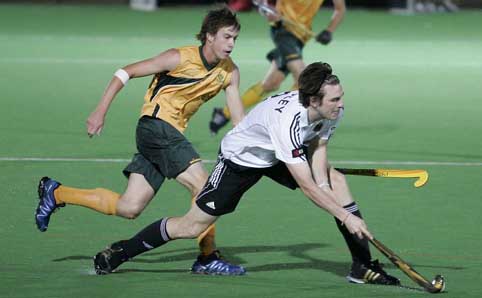Excellent facilities, pleasant weather and hospitality attract international teams
 |
|
Germany and South Africa played friendly practice matches at the UFS during their training camps.
Photo: Johan Roux
14 March 2012
|
Three international hockey teams have used the practice facilities of the university since the beginning of the year to prepare for the Olympic Games in August this year. The German and South African hockey teams have practiced here on four previous occasions.
Due to the cold weather in Europe, Austria also held its hockey training camp at the university this year. In addition, four of Austria’s triathlon athletes used the cross country track and swimming pool on the Bloemfontein Campus to prepare for the Olympic Games.
Germany’s national hockey team practised at the university from 3 to 12 March 2012. South Africa made use of the facilities from 5 to 10 March and Austria’s national team has been practicing in Bloemfontein since 24 February. From 3 to 10 March, a club team from Austria also made use of the university’s facilities, including the astros, the swimming pool, the athletics track and the Biokinetics Centre. SV Arminem also played two matches against the men’s hockey team from Kovsies. The first match end 2-2. With the second match Kovsies won 4-1.
Other international hockey teams who have made use of the astros over the past six years include Russia, Argentina, Belgium, China, Azerbaidjan and the Netherlands.
Staff ensured that everything ran like clockwork during the different training camps. Ms Annemarie Ludick and Mr Frans van der Watt, under the guidance of Mr Mickey Gordon, Head: Institutional Promotion, Fundraising, Marketing and Sport, were responsible for the logistical arrangements and finances. Mr Johan Gerber saw to the maintenance of the astros. The university boasts some of the best equipped astros in the world. “Germany, for example, did not bring along any exercise balls, cones, or beds (for use by physiotherapists) because the astros are fully equipped,” said Ms Ludick.
The fact that international teams such as Germany (ranked second in the world), South Africa and Austria made use of the university’s facilities is significant. “The university’s first team got for example the opportunity to play practice games against these players. The training camps also contributed to the economy of Bloemfontein,” said Ms Ludick.